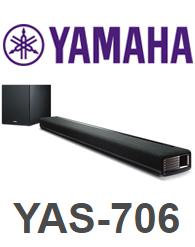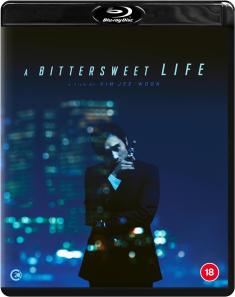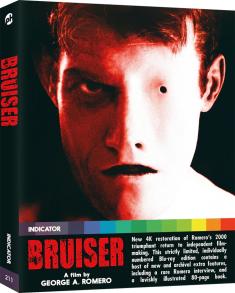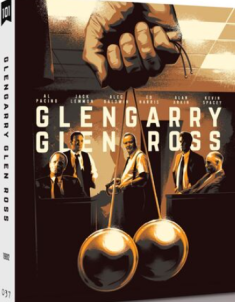Yamaha YAS-706 MusicCast Sound Bar
Overview -PROS
-Good movie and music performance
-Wide front soundstage
-Robust MusicCast connectivity
CONS
-Virtual surround mode is lacking
-No Dolby Atmos or DTS:X support
-Price is a bit high
-LED indicators hard to see and no text display
INTRO
Sound bars come in all shapes and sizes -- even from the same company. Serving as the sister line to Yamaha's YSP sound projector series, the Yamaha YAS sound bar lineup offers its own set of strengths and weaknesses, balancing some key positives and negatives that might make this series better or less suited for specific users.
As the collection's current top of the line model, the YAS-706 MusicCast Wireless Multiroom Sound Bar certainly has a lot going for it. Armed with robust connectivity options and a wireless subwoofer, the device makes for a worthy alternative to integrated TV speakers and space-hogging surround sound setups.
Likewise, the sound bar offers integrated woofers and a bit more power than the more expensive YSP-2700 (reviewed here). That said, the YAS-706 loses out on the YSP's more convincing surround sound mode and a few notable design perks.
But is that enough to declare one model superior over the other? Read on to find out!

SPECS & DESIGN
The YAS-706 is a 285 watt sound bar system with a wireless subwoofer and a virtual 7.1-channel surround sound mode. In addition to the speaker and woofer, the package also includes a remote control, an optical digital audio cable, a mounting template, and two spacers for wall mounting.
When it comes to design, the speaker features a pretty standard black color scheme with some silver accents on the side bass reflex ports along with a non-removable cloth grill across the entire driver array. Though not unattractive, I much prefer the sleeker metal grill design of the YSP series. The sound bar measures 37-3/8" x 2-7/8" x 5-1/8", providing a relatively compact form factor that should complement most displays nicely. Meanwhile, the subwoofer comes in at 11-5/8” x 11-3/4” x 12-1/8”, offering flexible placement options that suit many different room configurations.

Under the hood, the system features dual 2-1/8" woofers, dual 3" built-in subwoofers, four 3/4" tweeters, and two bass reflex ports. The system uses a triple amplifier drive with separate amps for treble, midrange and bass frequencies.
Sadly, unlike the YSP-2700, the YAS-706 does not feature a front panel text LED display. Instead there is a row of LED indicator lights located on the top of the sound bar. This placement makes it easy to see the status lights when the unit is wall mounted, but quite difficult or impossible when the unit is placed flat on a TV stand -- and this proved to be quite frustrating during my testing.
Finally, the back of the unit includes several connectivity options with support for numerous audio formats (all detailed below), including HDCP 2.2 compliant HDMI inputs with 4K HDR passthrough and Dolby TrueHD and DTS-HD MA playback.
Here's a full rundown of specs from Yamaha:
| General | Drivers | Dual 2-1/8” woofers, dual 3" built-in subwoofers, four 3/4" tweeters (center unit), 5-1/2" cone woofer (subwoofer) |
|---|---|---|
| Output Power | 285 W total power: 210 W + 75 W subwoofer | |
| Power Consumption | 38 W (center unit), 75 W (subwoofer) | |
| Standby Power Consumption | 0.3 W (center unit) (HDMI control, LAN, Wi-Fi, Wireless Direct, Bluetooth off), 2.5 W (HDMI control, Wireless Direct, Bluetooth on, LAN, Wi-Fi off), (subwoofer) 1.5 W ( wireless) | |
| Dimensions (W x H x D) | 37-3/8" x 2-7/8" x 5-1/8" (center unit), 11-5/8” x 11-3/4” x 12-1/8” (subwoofer) | |
| Weight | 11.9 lbs. (center unit), 20 lbs. (subwoofer) | |
| Input / Output | HDMI | 2 in / 1 out |
| Digital Optical | 1 in | |
| Digital Coaxial | 1 in | |
| Analog Audio | 1 in | |
| Subwoofer Output | Yes | |
| HDMI | 4K Pass-through | Yes (50 / 60 Hz YCbCr=4:4:4, HDR, HDCP 2.2) |
| 3D Pass-through | Yes | |
| ARC | Yes | |
| CEC | Yes | |
| Auto Lip-Sync | Yes | |
| Sound Technology | Surround Mode | Music, Movie, Sports, Game, TV Program |
| Bass Extended | Yes | |
| Surround Technology | AIR SURROUND XTREME | |
| Compressed Music Enhancer | Yes (for Bluetooth) | |
| Audio Formats | DTS Digital Surround | Yes |
| HD Audio Format Decoding | Yes | |
| Dolby TrueHD | Yes | |
| Dolby Digital Plus | Yes | |
| Dolby Digital | Yes | |
| Dolby Pro Logic II | Yes | |
| DTS-HD Master Audio | Yes | |
| DTS-HD High Resolution | Yes | |
| DTS | Yes | |
| DTS 96/24 | Yes | |
| File Format | MP3, WMA, MPEG-4 AAC; up to 96 kHz: Apple® Lossless; up to 192 kHz: WAV, FLAC, AIFF | |
| Connectivity | Wireless Music Streaming | Yes |
| Wi-Fi | Yes | |
| AirPlay | Yes | |
| Bluetooth Version/Profile | (Version) Ver. 2.1 + EDR / A2DP, AVRCP; (Codec) SBC, AAC | |
| Bluetooth Maximum Communication Range | 33 ft. (without obstructions) | |
| Ethernet | Yes | |
| Wireless Subwoofer | Yes | |
| Other Features | TV Remote Repeater | Yes |
| On-Screen Display | Yes | |
| On-Screen Display Languages | English, French, Spanish | |
| App Control | Yes (MusicCast Controller) | |
| Learning Function | Yes |
SETUP
Once unboxed, setup is a quick and simple process. Connect the sound bar to a display, plug in any additional playback devices, and power the unit on. The wireless subwoofer will then automatically pair with the speaker. After that, an initial setup screen will appear on the TV, allowing customers to configure a Wi-Fi connection for MusicCast functionality.
And though there are some other system settings that can be configured through the no-frills on screen menu interface, that's pretty much all there is to getting the sound bar up and running for wired connections. Unlike the YSP series, there is no IntelliBeam microphone for Digital Sound Projection calibration. Instead, the YAS-706 features a much more basic virtual surround sound process dubbed AIR SURROUND XTREME to simulate 7.1-channel playback.

AIR SURROUND XTREME offers sound programs optimized for different types of content, including Movie, Music, TV Program, Sports, and Game. Likewise, there is a standard Stereo mode as well that disables the virtual surround sound process. In addition, users can also toggle on a Clear Voice function for emphasizing dialogue and a Bass Extension mode for a boost in LFE.
All of these controls, along with volume, playback, and inputs, can be accessed through the system's simple yet functional remote. With that said, the process of actually activating and cycling between the different options leaves a bit to be desired. Instead of an on-screen indication or text panel on the sound bar, different LED lights and combinations of lights will be turned on depending on the mode selected.
As such, it can be hard to determine what each specific array of glowing lights actually means (the manual clears this up, but ideally users shouldn't need a key to figure out what mode is on). And since it's also very hard to see the LED panel when the sound bar isn't mounted, confirming whether or not options like the Bass Extension mode are engaged can be a chore. Thankfully, using the MusicCast iOS or Android app for settings clears up all these issues, allowing users to change volume, sources, surround sound modes, and other audio options from their mobile device. For this reason, I ended up preferring to use my smartphone for controls instead of the included remote.
PERFORMANCE
For movie testing purposes, I watched a variety of Blu-ray discs and streaming titles, including Finding Dory, Legion, The Avengers, Inception, and Game of Thrones, along with several clips from Dolby and DTS demos discs. With solid range and a wide soundfield, the YAS-706 offered a very engaging home theater experience -- even if its virtual surround sound mode couldn't live up to the sound projection tech found in the YSP series.
When switching to the Movie mode from the standard Stereo setting, the speaker created a noticeably expanded soundstage, opening up the scope of each mix nicely while properly decoding all of the Dolby and DTS surround sound formats it received (outside of Atmos and DTS:X). Likewise, two channel material was enhanced as well using Dolby Pro Logic II.
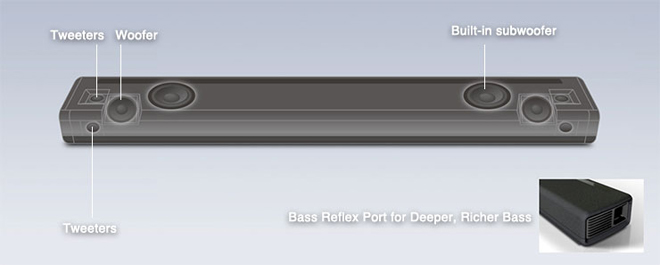
Running through my usual assortment of demo clips, the YAS-706 proved to be a versatile performer. The stampede scene in Dawn of the Planet of the Apes brought some nuanced effects work with slowly escalating jungle sounds that extended nicely with smooth imaging and solid left/right separation. Meanwhile, a DTS demo, titled Locked Up, was a good indicator of both the strengths and limitations of the AIR SURROUND XTREME tech. As buzzing flies circled around two frogs on screen, the sound bar demonstrated a convincing sense of distance and front-soundstage space, but there was never a sense of side or rear activity. For comparisons sake, I could actually walk around the room and hear different effects bounce off of different walls with the YSP-2700 sound projector, but here sound clearly only emanated from the unit itself.

Thankfully, despite the lack of a convincing virtual surround sound environment, the sound bar's front-loaded audio performance was still quite strong, producing each distinct laser blast, clanking hammer, roaring Hulk, and exploding alien ship during the busy Avengers invasion sequence. And when it comes to bass, the included wireless subwoofer complemented the speaker nicely. In fact, this appears to be the same subwoofer unit used with the previously reviewed YSP-2700, and though it never quite brings the truly room-shaking oomph that some users might be looking for, it balanced well with the sound bar without introducing any unwanted rattle.
Cycling through some bass heavy cues in X-Men: Days of Future Past, Transformers: Age of Extinction and Inception only yielded some very minor distortion with the woofer cranked to the max. On that note, I wouldn't recommend pushing it that high, as I ended up prefering to keep the sub levels at around 75% for the best balance (the default 50% seemed too low). Likewise, power as a whole was more than adequate for a small to medium sized room (I usually kept the volume at around 60% to 80%), though user's with larger entertainment areas will likely want to invest in a full surround sound system.
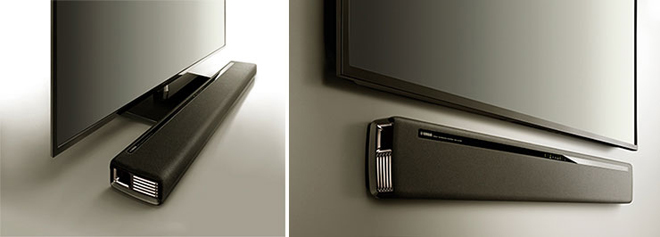
Outside of movies and TV shows, I also sampled the YAS-706 with a variety of streaming music tracks and MP3 files, including songs from Radiohead, Drake, Gnarls Barkley, Ariana Grande, Arcade Fire, Norah Jones, Pink Floyd, and Alessia Cara.
Similar to movie playback, music performance was also very good. For my tastes, I usually preffered to leave the sound bar in Stereo mode for a more authentic music presentation, but the Music mode opened up things nicely without overdoing the surround effect. The overall sonic profile was balanced well with no egregious issues, though the mids could sound a little flat in certain tracks. On that note, modern pop tracks tended to sound the best, offering a bit more dimension and, well, pop. As with the YSP-2700, however, bassheads who like to feel each beat in their gut will probably be left unsatisfied.
Though the surround mode here is disappointing compared to Yamaha's sound projection tech, the AIR SURROUND XTREME process still offers a notable improvement over standard stereo playback. Whether using the Movie mode for films and TV or the Music mode for audio files and streaming tracks, the YAS-706 performed admirably with pretty much any material I threw at it, compressing a well-rounded home theater experience into a space-saving sound bar.
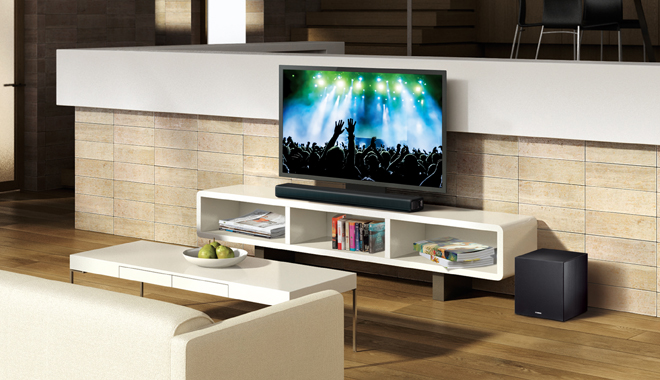
MUSICCAST & BLUETOOTH
In addition to wired connections, the sound bar also features several wireless connectivity options, including Bluetooth and Yamaha's MusicCast multi-room audio technology, which allows users to setup different speakers throughout multiple rooms on the same household Wi-Fi connection.
When it comes to standard Bluetooth, performance was exactly as one might expect, equaling the painless process I experienced with similar MusicCast products. I simply located the sound bar on my Samsung Galaxy S7, paired the devices, and started playing MP3 and Spotify tracks from my smartphone. Quality was solid and the tracks came through nicely in the stereo or Music mode. Likewise, the unit automatically engaged a Compressed Music Enhancer mode when compressed tracks were played over Bluetooth.
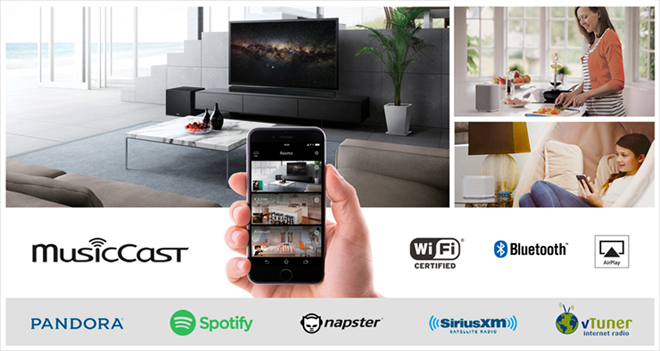
Initial MusicCast setup was also painless, quick, and straightforward. I simply downloaded the MusicCast app from the Google Play Store and then wirelessly connected the device to the smartphone through Wi-Fi by briefly pressing the connect button on the unit. From there, I was able to setup a location and room on the mobile app, allowing me to wirelessly control the sound bar and play music stored on my phone, along with access to Pandora, Spotify, Napster, SiriusXM Internet, and thousands of internet stations.
In addition, I was even able to seamlessly link the sound bar to another Yamaha MusicCast speaker, the WX-010 (full review here), allowing me to play the same track from any MusicCast source in two different rooms with independent or linked volume control. Likewise, I could also play two different music tracks from different sources on each device from the app at the same time. For instance, I played an MP3 file off of my smartphone storage on the YAS-706 while simultaneously streaming Pandora to the WX-010.
Even more impressive, the MusicCast tech allowed me to send audio from Blu-ray discs and apps on my smart TV (like Netflix and Spotify) to the WX-010 in a separate room, letting me play the Roger Waters The Wall Blu-ray concert disc in my living room and also hear it on the WX-010 speaker in my bedroom. Throughout it all, MusicCast playback and control was essentially seamless, with no major quirks or technical issues.
FINAL THOUGHTS
With good overall audio performance and fantastic MusicCast wireless connectivity, the Yamaha YAS-706 cements itself as a very worthy sound bar solution for small to medium-sized rooms. With that said, though it offers a wider soundstage, the virtual surround mode isn't very convincing -- especially compared to Yamaha's own sound projection tech found in the company's YSP sound bar lineup
On that note, at around $1,000, I can't help but feel like this model is a little too expensive. For $200 more, customers can opt for the YSP-2700 model and receive a much more enveloping simulated surround sound experience, along with a better design. Of course, overall power output and driver performance is a little less robust on that model, so there's a bit of a trade-off, but I have to lean much more toward the 2700. Likewise, there are a few solid home-theater-in-a-box and budget-range surround systems available in this same price range -- some even with Dolby Atmos and DTS:X support like the Onkyo HT-S7800 (full review here).
Still, if space is an issue and you're looking for a simpler plug-and-play solution without any extra calibration, the YAS-706 is definitely a strong performer for its class.
Worth a Look.
